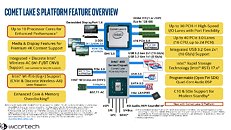Tuesday, December 10th 2019

Intel Core i9-10900K 10-core Processor and Z490 Chipset Arrive April 2020
Intel is expected to finally refresh its mainstream desktop platform with the introduction of the 14 nm "Comet Lake-S" processors, in Q2-2020. This sees the introduction of the new LGA1200 socket and Intel 400-series chipsets, led by the Z490 Express at the top. Platform maps of these PCI-Express gen 3.0 based chipsets make them look largely similar to current 300-series platform, with a few changes. For starters, Intel introducing its biggest ACPI change since C6/C7 power states that debuted with "Haswell;" with the introduction of C10 and S0ix Modern Standby power-states, which give your PC an iPad-like availability while sipping minimal power. This idea is slightly different from Smart Connect, in that your web-connected apps and processor work at an extremely low-power (fanless) state, rather than waking your machine up from time to time for the apps to refresh. 400-series chipset motherboards will also feature updated networking interfaces, such as support for 2.5 GbE wired LAN with an Intel i225-series PHY, 802.11ax WiFi 6 WLAN, etc.
HyperThreading will play a big role in making Intel's processor lineup competitive with AMD's given that the underlying microarchitecture offers an identical core design to "Skylake" circa 2015. The entry-level Core i3 chips will be 4-core/8-thread, Core i5 6-core/12-thread, Core i7 8-core/16-thread; and leading the pack will be the Core i9-10900K, a 10-core/20-thread processor. According to a WCCFTech report, this processor will debut in April 2020, which means at CES 2020 in January, we'll get to see some of the first socket LGA1200 motherboards, some even based on the Z490. The platform also mentions an interesting specification: "enhanced core and memory overclocking." This could be the secret ingredient that makes the i9-10900K competitive with the likes of the Ryzen 9 3900X. The LGA1200 platform could be forwards-compatible with "Rocket Lake," which could herald IPC increases on the platform by implementing "Willow Cove" CPU cores.
Source:
WCCFTech
HyperThreading will play a big role in making Intel's processor lineup competitive with AMD's given that the underlying microarchitecture offers an identical core design to "Skylake" circa 2015. The entry-level Core i3 chips will be 4-core/8-thread, Core i5 6-core/12-thread, Core i7 8-core/16-thread; and leading the pack will be the Core i9-10900K, a 10-core/20-thread processor. According to a WCCFTech report, this processor will debut in April 2020, which means at CES 2020 in January, we'll get to see some of the first socket LGA1200 motherboards, some even based on the Z490. The platform also mentions an interesting specification: "enhanced core and memory overclocking." This could be the secret ingredient that makes the i9-10900K competitive with the likes of the Ryzen 9 3900X. The LGA1200 platform could be forwards-compatible with "Rocket Lake," which could herald IPC increases on the platform by implementing "Willow Cove" CPU cores.

96 Comments on Intel Core i9-10900K 10-core Processor and Z490 Chipset Arrive April 2020
Disabling HT does NOT make a system secure. CPU has other security flaws that haven't been found or revealed yet.They're adding pins. This could be because of added PCIe, higher IGP transfers or other features unknown at this point.
Socket/package size is the same as in LGA1151 and LGA1150.
As for socket size being a limiting factor for core count...
A 4-core SB die was 24% larger than an 8-core CL (below, from wikichip).
Without GPU, 12 cores should fit in SB's 216mm2.
And, of course, both cores' and cache's shape/size can change, so only Intel and partners know the answer at this point.
We can get 16 core, but it would sacrifice the iGPU, it can't fit, outside the limits. and it will draw 500 watts in prime 95 at 5.00Ghz, 9900K draws 250 watts.
For now, only gets 10 core. next year 12, every year is +2 then +2.
Not seeing any reason to wait till April to spend even MORE capital on 2 more cores I don't need.
also, LOL; 10nm.
I don't think it will be much larger.Physically, Intel could easily have fitted 16 cores on this socket (in a 4x4 mesh), but it's not really practical nor is it really needed. On 14nm, their i9-9900K is already throttling unless the power limit is removed.
While it's good to have more than 4 cores on the mainstream platform, we really don't need 12-16 cores for non-server software (except for special use cases). Most applications will scale much better on a 30% faster CPU vs. a CPU with 30% more cores. Intel need to focus on bringing their new architectures to the market rather than winning "the core race".
For what exactly, they're still limited by DMI 3.0 IIRC.
Nope.
The only "unknown" feature they're adding is CNVi & I question it's much touted utility on desktops.
Also, why would anyone run 9900K at const 5GHz? It makes absolutely no sense. And that's exactly why people think Intel CPUs draw so much power.
Blame AMD for starting a core race in the first place. They are the ones who brought this HCC crap to the mainstream segment. :)
There's very little need for more multi-thread performance in this segment... and even less will to sacrifice single thread potential.
It's hard to say how Intel will segment their next generation into traditional product lines. They'll have to stretch something. But it's extremely unlikely that 2-core, non-HT CPUs won't be included.
Please don't say the chipset and the nr of PCIE-E lines only...
and intel just screw their head with 4 "NEW" intel product xD and soon 5 skylake refresh